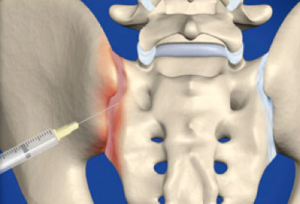Injection into the sacroiliac joint is also called an SI joint injection, an SI joint block, or a sacroiliac joint block. It is commonly utilized in the treatment of low back pain or the diagnosis of low back pain in those suspected of having sacroiliac dysfunction and pain.
Where is the Sacroiliac Joint?
The sacroiliac joint is located where the sacrum joins up with the pelvis bone, known as the ilium. There is one on each side of the sacrum. The joint has cartilage just like any other weight bearing joint, and is prone to arthritis and pain. Although the sacroiliac joint does not have a lot of motion associated with it, there is enough to generate considerable pain if there is degeneration associated.
The SI joint has been shown to be a significant cause of low back pain in individuals approximately 15 to 25% of the time.
Why are SI Joint Injections Performed?
There are two reasons for performing a sacroiliac joint injection. One is to diagnose the source of an individual’s pain, and the second is to provide pain relief. These two reasons may overlap in the same person and get combined into one injection.
Sacroiliac injections can help alleviate pain during an arthritic flare up in conjunction with pain medication, physical therapy, chiropractic treatment, and a TENS unit. There is no great surgical option for SI Joint dysfunction, so injections represent an excellent treatment option.
Typically an SI joint injection includes numbing medicine along with cortisone (steroid). The numbing medicine may last upwards of 24 hours, at which point the cortisone typically “kicks in” and last for a few weeks to a few months.
Who can benefit from a sacroiliac joint injection?

Individuals suffering from a problem with SI joint pain may benefit tremendously from one of these injections. Arthritis in the SI joint is very common, as the joint has cartilage just like any other in the body and accounts for 15-20% of all chronic low back pain problems.
There is slight movement associated with the sacroiliac joint which can lead to pain in those with significant arthritis. Besides injections, treatment for SI joint pain typically consists of anti-inflammatory medications, physical therapy, chiropractic treatment, TENS units and pain medication. Surgery for a painful SI joint is typically not the best idea, therefore if an injection can work well, it will provide an excellent nonoperative treatment option for SI joint dysfunction.
Call (602) 507 – 6550 to schedule your Appointment TODAY!

How is a Sacroiliac Joint injection performed?

Sacroiliac Joint Injection
These injections are done as an outpatient and the patient goes home the same day. They typically will not require IV sedation and are done under numbing just under the skin and down towards the joint. In those who have anxiety with procedures or needles, IV sedation may be necessary. Patients are placed in the prone position which is with their stomach down. The area is sterilized and the skin is numbed with the needle then being placed into the sacroiliac joint. If you have ever seen a model of the sacroiliac joint, you can see that it is significantly irregular and difficult to potentially get into, especially when significant arthritis and bony overgrowth is present. The angle necessary to successfully get into the joint with the needle may be counterintuitive and extreme.
Therefore most experienced pain management doctors will use fluoroscopy to assist with accuracy. This is a real-time form of x-ray that can show where the needle is at any given point in time. Once the pain doctor is satisfied with needle placement, a slight amount of contrast dye is injected to ensure satisfactory position.
At that point once the position inside the joint is established, numbing medicine along with steroid is injected into the joint itself. Sometimes doctors will also inject numbing medicine and steroid outside the joint in the immediate area in an effort to numb the nerves providing sensations to the joint itself for additional pain relief.
The numbing medicine and the steroid will work its way through the joint and provide pain relief to the inflamed irritated areas. The procedure itself typically takes less than 20 minutes.
How well does a sacroiliac joint steroid injection work?
Chronic low back pain is an affliction that may cause periods of intense pain and others of a minimal problem. When the low back pain is due to a sacroiliac joint problem, the situation is no different. These injections are minimally invasive and maintain low risk, and may provide a substantial decrease in pain while allowing individuals to perform recreational  and social activities better.
and social activities better.
Studies have shown that SI joint injections Are preferred to the traditional methods of treatment and provide on average over an 85% effectiveness for pain improvements with a low risk profile (Maugars et al, 1996, Br Journal Rheumatology).
What are the risks of a sacroiliac joint injection?
This is a low-risk procedure. It is not a risk-free procedure, however, and those risks include a small potential for infection, bleeding, nerve injury, anesthesia complications or side effects from the steroid injected.
What other treatment options are available for sacroiliac joint pain?
If the sacroiliac joint injection works well and the pain comes back within a few weeks to a few months, it may simply be repeated with typically excellent results. Keep in mind that surgery for sacroiliac joint arthritis has not shown to be extremely beneficial, so these injections may make the difference in pain relief to a suffering individual.
An additional option that is becoming more popular is a radiofrequency ablation of the sacroiliac joint, which is also called a radiofrequency neurotomy. This involves destroying the small little nerve endings that supply the SI joint with sensation and hence pain. These are called the medial and lateral branches and 50-80% pain relief may result from this procedure with the duration ranging from six weeks to over a year (Pain Medicine, 2006, Vallejo et al).

Those tiny nerve endings will grow back eventually. Additional treatments that have been shown to work well for SI joint pain include physical therapy, chiropractic treatment, TENS units, acupuncture along with medication management. There are injections being performed now with nonsteroidal medication, and in addition as a last resort with low back pain spinal cord stimulation implants are showing more effectiveness these days.
If you’re suffering from low back pain, Arizona Pain Specialists can help. They are experts in sacroiliac joint injections along with radiofrequency ablation, and have multiple additional options to help. These include physical rehabilitation, chiropractic treatment, acupuncture and medication management. There are Valleywide locations serving Phoenix, Chandler, Glendale, Scottsdale, Mesa, and more. The office takes most major medical insurance along with Workers Compensation, Medicare, AHCCCS, Personal Injury, and self-pay options.
Call (602) 507 – 6550 to schedule your Appointment TODAY!

![]()




 and social activities better.
and social activities better.